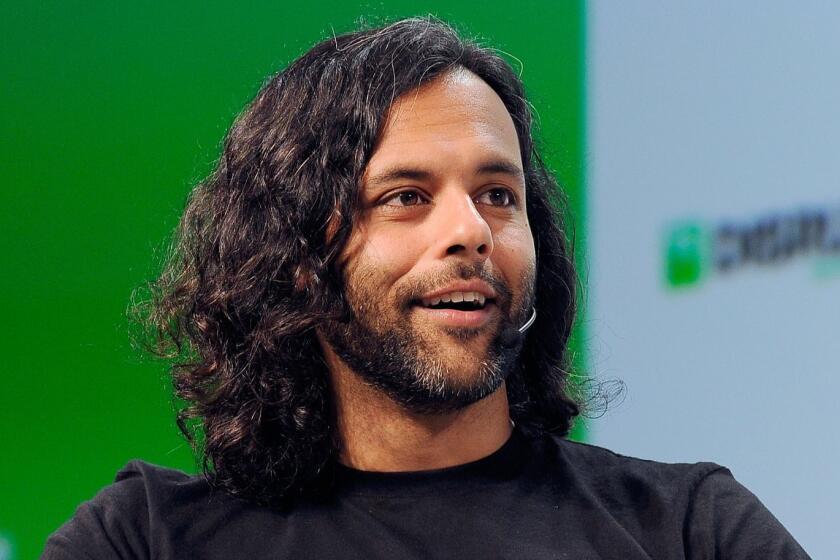No banking charter? No problem. Fintech companies team up with small-town banks
- Share via
Customers of Square Inc., the Silicon Valley payments behemoth, might assume that the cash they send to friends on the platform is housed in a glassy building in Silicon Valley, tended to by hoodie-clad tech workers. Actually, that money is more likely to be sitting in a 117-year-old community bank in Iowa.
Partnerships between high-flying tech companies and traditional banks, many of them tiny by comparison, are a key force behind the financial technology boom. Because virtually no tech companies have the license required to perform banking services, many of them partner with existing banks to offer a suite of services including checking accounts, credit cards and the back-end and regulatory work the tech companies aren’t equipped—or allowed—to handle.
Now, driven by the tech industry’s thirst to jump into finance, a new crop of businesses are looking to broker the connections between tech and banks. One such business is Cambr, a little-known division of an investment company called StoneCastle, which counts Square and other fintechs as customers. StoneCastle works with more than 800 small banks, spread across the country, ready to take and hold deposits from Silicon Valley start-ups such as Square.
“Airbnb, one would argue they are one of the largest hotel chains that doesn’t own a room,” said Josh Siegel, chief executive of StoneCastle Partners LLC. “Our network works in a similar way. We have an account at the bank, it’s the room we rent, and we can rent it out to whoever we want.”
Cambr’s service launched last year as a partnership between StoneCastle, which provides the bank connections, and digital banking platform Q2 Holdings Inc., which works on the software and programming. Square’s Cash App was one of Cambr’s first customers, Siegel said, and it has since added start-ups such as Acorns Grow Inc., MoneyLion Inc., Qapital Inc. and robo-advisor Betterment LLC, in a recently announced deal.
What Cambr aims to offer tech companies is a ready-made strategy to accept deposits that they wouldn’t otherwise have the license to handle.
Here’s how it works: A tech company or start-up might give Cambr as much as $100 billion of customers’ cash, and could then ask the service to spread the money around to potentially hundreds of different financial institutions. A result of spreading out the deposits is that more of the fintech’s cash is insured under the Federal Deposit Insurance Corp.’s $250,000-per-account guarantee, offering more coverage than if the money were deposited at a single institution.
The partnership model, which has rapidly become the go-to for financial technology companies, does pose some risks for banks, particularly if fast-moving start-ups draw the ire of regulators, as has happened before.
“The banks are the supervised entities so the buck stops with them,” said Brian Korn, partner and head of fintech practice at Manatt, Phelps & Phillips. “The regulators are waiting for situations where there’s a breakdown.”
On Thursday, Robinhood Financial LLC announced a new product called “Robinhood Checking & Savings,” which would allow anyone to open a deposit account with no-fee ATM access, a debit card, insurance from the Securities Investor Protection Corp. and a 3% interest rate.
But many community banks have embraced such partnerships, seeing them as a salve in times of digital disruption. More deposits can allow small banks to grow and make more local loans. In Cedar Falls, Iowa, the 117-year-old Lincoln Savings Bank, which works with Cambr, has boosted its revenue by partnering with fintechs, said Mike McCrary, who runs e-commerce and emerging technology for the bank. McCrary said that when Lincoln Savings Bank considered how it could best position itself for the next 10 years, fintech partnerships were an obvious answer.
“In order for us to be relevant years from now, there had to be something digital,” he said. “Now we’re putting a lot of resources into this area of our business,” including, he said, building out a new team dedicated to working with tech companies.
While the partnerships have injected cash into many small banks, some industry watchers have wondered if those banks could be left in a lurch if fintechs eventually got their own banking charters. If they did, community banks could find themselves as direct competitors to tech companies, without the same digital capabilities.
But so far tech companies have made scant progress toward winning banking charters, particularly as government concern over digital financial services has grown. Some members of the U.S. Federal Reserve have voiced concern over fintech’s risk management capabilities. And Facebook Inc.’s foray into cryptocurrency has drawn ire from lawmakers.
One option for tech companies has been to apply for an Industrial Loan Charter, which would effectively grant them license to provide financial services. Square first applied for the charter in the fall of 2017, but its request shows no signs of being approved. Social Finance Inc. also applied for an ILC, but withdrew its application altogether.
“It’s not easy to become a bank here, and we haven’t seen much traction in general with the ILC,” Matt Burton, partner at venture capital firm QED Investors, said. “What we have seen is continued demand for non-banks to offer banking solutions.”
Andrei Cherny, who pivoted to finance from a career in politics, has raised $110 million from venture capital firms for his financial tech outfit.
Partnering with multiple small banks is just one option for fintechs. Some have teamed up with one big bank instead — like Apple Inc., which developed a credit card with Goldman Sachs Group Inc. But there are advantages to Cambr’s many-bank strategy. Some tech companies favor “the network approach over the big bank because they can negotiate better rates because both parties are getting something they want,” said Lindsay Davis, a senior analyst at CB Insights. Smaller banks are also more likely to play ball because they aren’t developing competing services.
“For the big banks, they are optimizing for customer acquisition and cross-selling services,” Davis said. “So a tech firm getting into financial services might be cannibalizing an existing business.”
Joe Yeres, Cambr’s vice president of business development, is partly responsible for brokering the connections with community institutions, and travels a few times a month to places such as Waterloo, Iowa, and Kansas City, Mo., where some of the banks it works with are located. The trips were eye-opening, Yeres said.
“I was born and raised in New York metro, so the whole thing is a little funny to me,” Yeres said. “I was done with one of the leads of the banking team, and we went out for drinks after work one day, and walking around Waterloo it was like this guy was the mayor, everyone knew him. It was like, ‘Wow, this is how this part of the world works.’”
Eventually, Cambr has its sights set on a bigger prize: It wants to handle deposits from the tech giants, not just the start-ups. Many industry watchers believe large tech companies will eventually move to offer more financial services, as Apple already has with the Apple Card and Amazon.com Inc. has with small business lending. But Siegel realizes that Cambr, the little-known product of the relatively little-known StoneCastle and Q2, faces some hurdles.
“Do they want to take a risk on a younger platform?” he asks, and in doing so, “upset big finance, which they’ll still have to work with on some things?”
Still, Siegel is pitching the titans of tech, as they continue to march deeper into the world of finance. He adds: “We’ve probably been out and visited with almost all of them.”
More to Read
Inside the business of entertainment
The Wide Shot brings you news, analysis and insights on everything from streaming wars to production — and what it all means for the future.
You may occasionally receive promotional content from the Los Angeles Times.












